The past, present and future of ASUS, according to its chairman

"Namaste!"
That was how ASUS Chairman Jonney Shih greeted some 2,000 fans at his "ZenFestival" event in New Delhi last week. And yes, he yelled on stage, just as he always does, with a generous helping of buzzwords and "thank yous." And there have been other memorable moments. One time, Shih "performed" a magic trick to extract a PadFone out of the back of a tablet, and later he "conducted" an orchestra of audio-centric laptops that were blasting out music. But don't be misled by his seeming goofiness: This is also a man who's evolved from stamping out motherboards to building smartphones. There's no better person than Shih, then, to tell us how times have changed for his 26-year-old company, and where ASUS is headed next.
The bumpy ride from Acer to ASUS
ASUS was founded by T.H. Tung, Ted Hsu, Wayne Tsiah and M.T. Liao in April 1989. Notice that Shih wasn't part of the founding team, but he was still very much involved from day one.
We dreamed about how to start up a small but beautiful company.
"Let me tell you the real story," the 62-year-old exec said, while pouring some Chinese tea. "At the beginning, those four engineers were my engineers, and we were with Acer, and I had been in charge of Acer's R&D for quite a long time (12 years). One time, at a cafeteria, we dreamed about how to start up a small but beautiful company. They all elected me to lead them."
At the time, Jonney was reporting to Stan Shih, the then-chairman and CEO of Acer. The two Shihs are not related, but young Jonney looked up to Stan as his mentor, so he went to ask for Stan's blessing to let him start a new company. Stan convinced Jonney to stay, since Acer wasn't in great shape — largely due to a downturn in the US economy at the time. Still, Jonney ended up supporting the team of engineers by providing 60 percent of their startup funding, and Stan was fine with that.
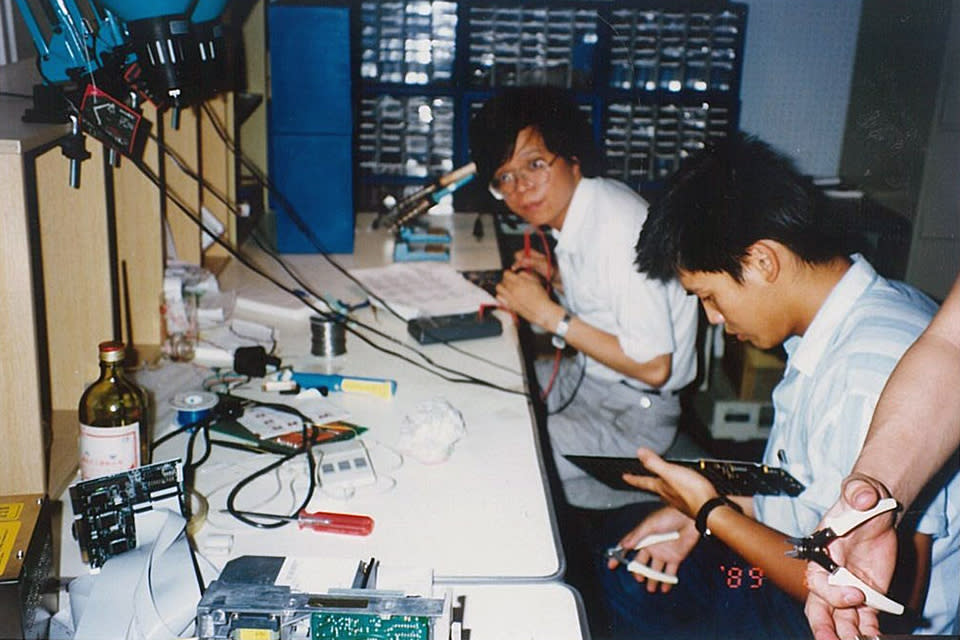
ASUS in the form of a tiny workshop in its first year. Jonney Shih didn't join until three years later.
Without Jonney Shih's direct guidance, the ASUS co-founders were still able to make a huge breakthrough. In its second year, the startup beat its local rivals and launched an Intel 486 motherboard around the same time as IBM. But unlike the American giant, ASUS achieved this feat without getting a preview of Intel's chip; the engineers based their motherboard design on their understanding of earlier chipsets. Intel was so impressed that it started giving ASUS early access to its upcoming CPUs, and ASUS would later manufacture motherboards for the likes of Dell, HP and Sony.
Fast-forward to 1992: The two Shihs finally got Acer back into shape, but it was quite the opposite for ASUS. The company was suffering from quality issues plus a loss of "second-generation" engineers. Jonney recalled how he came across ASUS' empty lab at around 5:30PM one evening, which was a worrying sign for what was supposed to be an ambitious startup. He also implied that the young co-founders often struggled to come to a common ground over issues regarding business and technology, and would often seek his advice.
Jonney asked Stan once again to let him join ASUS. Seeing that Acer was in good health, this time Stan gave the go-ahead, under the condition that Jonney would take a half-year break beforehand.

Best friends forever: Shih supporting former Intel exec Sean Maloney for completing his Heart Across America cycling campaign. Maloney is credited for the creation of ASUS' Eee PC netbook category.
Soon after taking charge of ASUS, Shih quickly started working on replenishing ASUS' talent pool, which wasn't easy for the tiny company. He would pick up the phone and work through a list of graduates he obtained from his alma mater, the National Taiwan University, to convince them that they would learn a lot by joining ASUS.
Fortunately for Shih, most of the candidates were so touched after their phone call with him they ended up joining ASUS. What won them over was probably the fact that Shih was also an electrical engineering graduate, and his passion for the science was — and still is — apparent. The exec would later set up electronic classes for the software engineers, and vice versa for the electronic folks.
Fundamentals
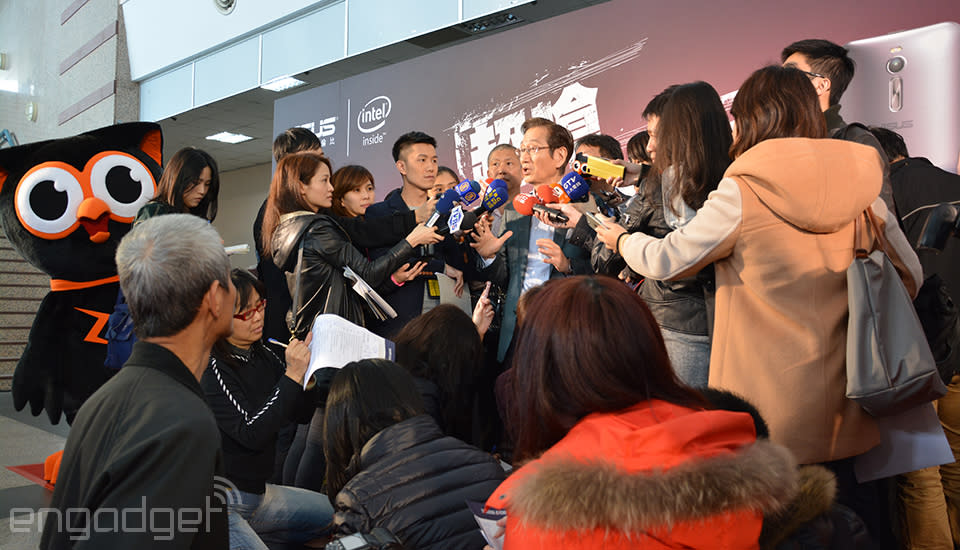
Not even ASUS' cute mascot, Zenny, could steal people's attention away from Shih.
Today's ASUS is over 13,800 people strong, around 6,000 of whom are based in Taiwan. Even though the company now offers a broad range of products including laptops, tablets, all-in-ones, smartphones, graphics cards, routers and more, it is still very active in the motherboard market. In fact, at the beginning of this year, ASUS sold its 500 millionth motherboard.
It's worth noting that ASUS has long stopped making motherboards for other companies. The OEM business was offloaded to its subsidiary Pegatron in 2008, before that company was spun off completely two years later. And, while it's more famous for manufacturing iPhones and iPads these days, it also still makes devices for ASUS.
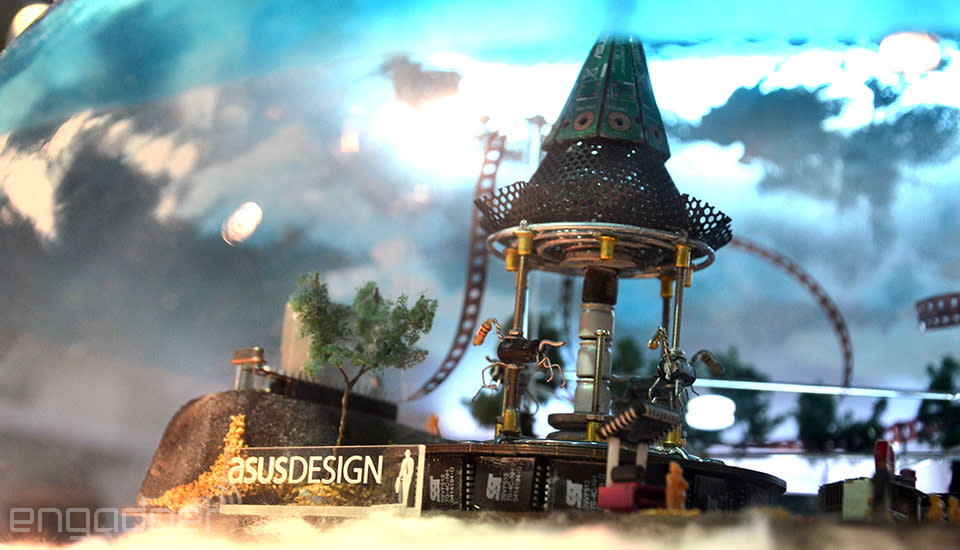
An art installation made of ASUS motherboard parts.
Despite the growing number of laptop and tablet users, Shih believes there is always room for motherboards in the consumer market, courtesy of power users. From an R&D perspective, the motherboard is where engineers can go back to the fundamentals, as well as experiment with the latest technologies that will eventually be applied to other products. It's no wonder the Zen Garden, situated at the heart of the ASUS campus, resembles the layout of a motherboard.
Can you feel the electromagnetic wave? If you don't, go back.
"I always ask my engineers that when you take this [motherboard], can you feel the electromagnetic wave? If you don't, go back," Shih chuckled, but he was serious. What he means is even if you're just looking at digital signals, they can still be affected by noise and interference due to the nature of electromagnetism. But if the engineers still don't understand where the issues are coming from, then Shih would tell them to go "read the electromagnetic theory 20 times," because that's what he would do as well.
Shih knows his science. After all these years, he still shows a lot of enthusiasm when talking about calculus, Maxwell's equations, high-speed signal design, signal simulation, quantum physics and even the theory of relativity. If that's not a sign of a true geek, then nothing is.
When design meets engineering
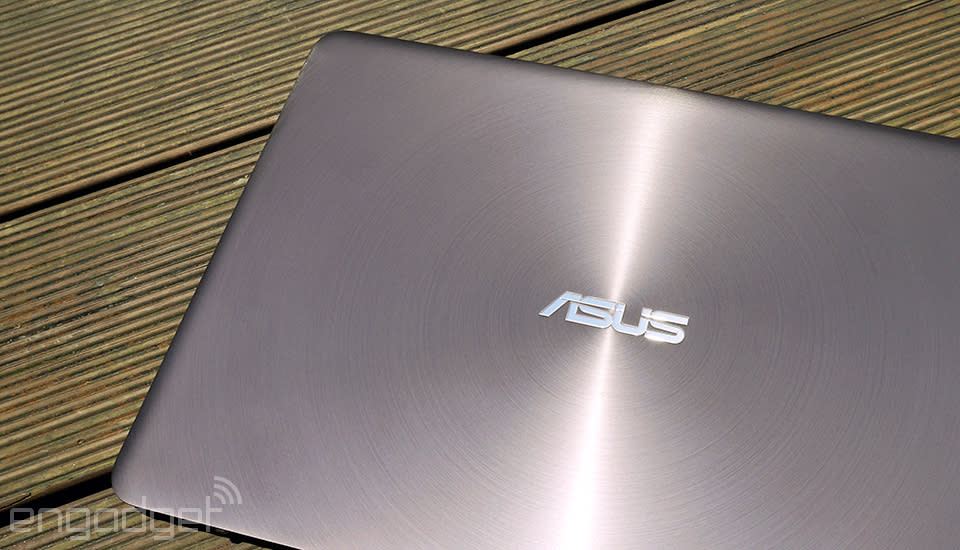
The ASUS ZenBook UX305.
What sets Shih apart from many engineers is his well-known appreciation of classical arts, which contributed to his determination to strive for perfection. For instance, he followed in his grandfather's footsteps by picking up Chinese calligraphy, which is an art that requires regular practice to achieve significant improvement. Shih is also a fan of Mozart's music, and in his opinion, the musician's real breakthrough wasn't until his "Piano Concerto No. 7." "Even a genius has to practice at least 10,000 hours," he said. This is the kind of spirit that he expects in his team: Keep practicing until you truly understand your work.
But not everyone's an artist, as some engineers would confess to Shih. Sometimes, he said, they would get too absorbed in debugging a product, and end up not understanding why it doesn't sell well. To push his colleagues to their maximum potential, Shih has since set up mandatory classes on "design thinking." This methodology is nothing new in the design industry: It's all about product developers putting themselves in consumers' shoes; thinking out of the box; and striking the right balance among desirability, financial viability and technical feasibility. That way, the products are more likely to be embraced by consumers.
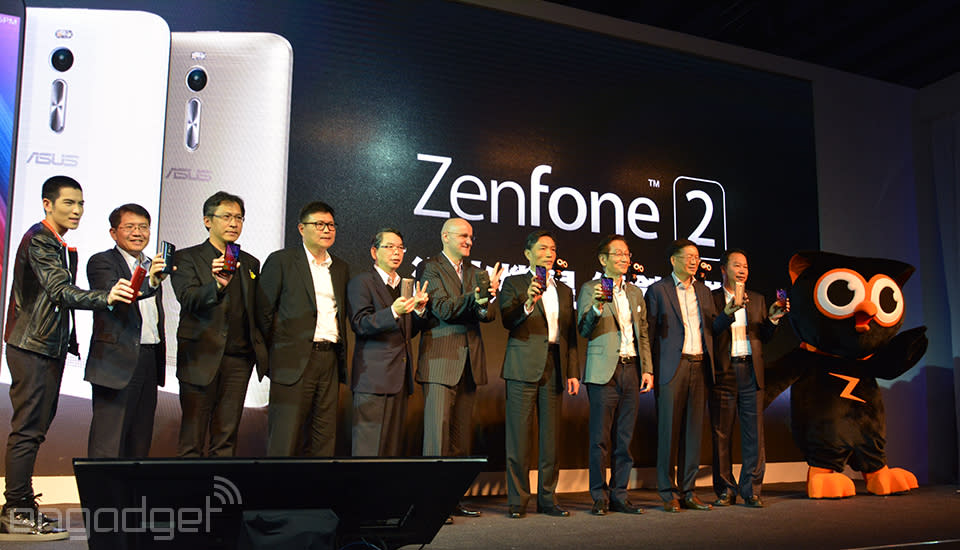
ASUS launched the ZenFone 2 in Taipei back in March.
In Shih's opinion, the ZenFone 2 is a good example of design thinking. It's very affordable, but still packs an impressive punch in the specs department. Plus it looks and feels solid, even if it sticks to plastic for the body. The numbers reflect some success in certain regions. According to research firm BCN, ASUS topped Japan's SIM-free smartphone market with a 29.6 percent market share in the first half of 2015. Specifically, the ZenFone 2 ranked number three in July, which was already its second month in the country. On the other side of the world, the ZenFone 2 is listed as the top and second best seller on Amazon in Italy and the US, respectively, at the time of publication (Amazon updates its list hourly). Looking ahead, the company expects to ship 25 million smartphones this year, though Shih wouldn't confirm whether the upcoming high-end PadFone refresh would fall into this window.
But can ASUS fend off other aggressive smartphone brands such as Xiaomi, OnePlus and Huawei? Shih said it's inevitable that consumers will be drawn to the best blend of price and performance, and his company has to go with the mobile trend or else risk becoming irrelevant. The least his team could do is to follow the old wisdom and focus on customer happiness.
Next stop: robotics and more

Big data and robotics would complete the third generation of the industrial revolution.
At Computex, ASUS already announced plans for its smart home ecosystem, which include door and window alarms, smart power peripherals and IP cameras. But the company isn't stopping there. Throughout the interview, Shih kept name-dropping his company's mysterious advanced research center, the Da Vinci Lab, a few times — mainly to tease ASUS' next big thing: big data and robotics. "That would complete the third generation of the industrial revolution," he said.
The work going on inside the Da Vinci Lab is pretty secretive, but its location isn't. According to OpenStreetMap, if you stroll across the street from ASUS HQ's main entrance and make a left turn, you'll see a convenience store at the corner. If you happen to be a deliveryman looking for the store's back entrance, you might just accidentally walk into the lab. This is where ASUS came up with its scented laptop, its first-ever tablet and its PixelMaster camera technology to boost low-light sensitivity. A quick search on Google also reveals the lab's development on natural language processing.
So what's hiding behind the curtains in the Da Vinci Lab at the moment? Shih teased that he's personally driving a robotics project. The aim is to come up with a machine that can proactively interact with humans, so it'll probably be similar to Pepper and other intelligent robots (in fact, Nikkei's teardown revealed that Pepper's depth-sensing camera is made by ASUS). We may see it as soon as next year, if ASUS can keep up with its "very aggressive schedule."
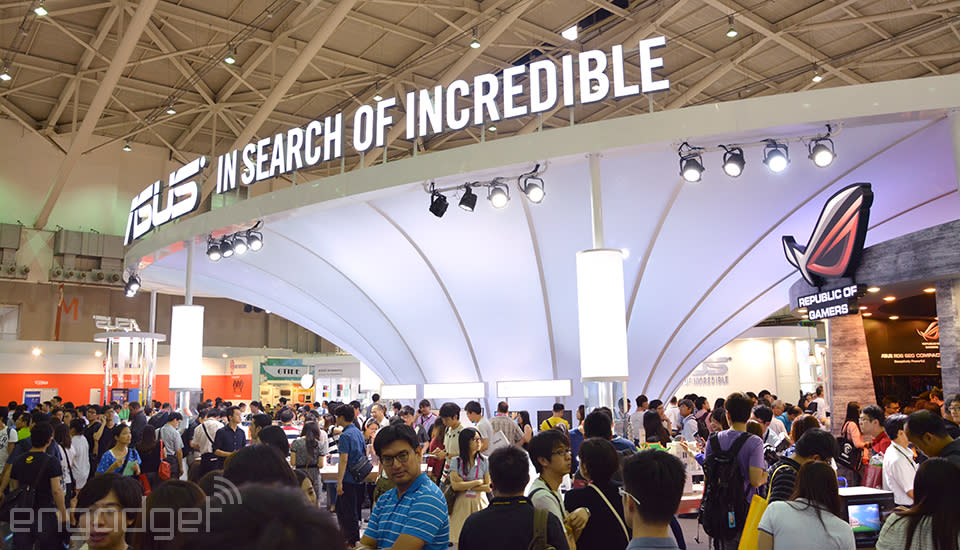
ASUS booth at Computex 2015.
With such high ambitions and recent achievements, ASUS is a stark contrast to some of its local rivals: HTC is practically worthless now, though it may revive with other types of products; Acer's struggling big time after a major reshuffling; and Gigabyte has suspended its smartphone operations as of last month. In Shih's view, many of the Taiwanese PC makers relied too heavily on Intel plus Windows, and just focused on driving the specs. The only way out now is to upgrade themselves in all aspects. "No cheating," Shih said with a grin.
[Image credit for first three photos: ASUS; video taken with help from Ross Wang and Andy Yang at Engadget Chinese]

